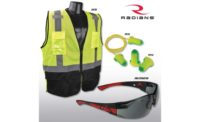 Compiled by industrial safety marketing and communications experts Miller Pierce www.millerpierce.com 317-228-1262; Indianapolis, IN
Compiled by industrial safety marketing and communications experts Miller Pierce www.millerpierce.com 317-228-1262; Indianapolis, IN
1 — Safety is playing a more significant role in operations.
Over the past five years, the role of safety management has been redefined. Selection of best-suited PPE, employee training, compliance assurance and ordering and stocking have required companies to elevate the necessity for safety personnel to have a seat at the operational table. Increasingly, safety managers have specialized skill sets, including college degrees in safety, employee health and safety or industrial hygiene. The safety mentality has shifted from “We’ll do the best we can” to “We are the best.”
Bottom line: Safety is now woven into the fabric of operational excellence.
2 — Safety records are the most important measurement for operational excellence.
In a recent research project where more than 450 plant managers were interviewed from a cross section of all the key industrial markets, participants were asked “What are the top five ways you measure operational excellence?” The number one way the majority of participants measured their operations was via an analysis of safety records. Safety records were more important than training records, quality control reports and cost per unit measures.
Bottom line: Manufacturers and distributors need to offer support to their facility-level customers in the important area of documenting, capturing, analyzing and making operational decisions that achieve accurate, timely and reportable metrics for driving a successful safety record process.
3—Training records are the second most important measurement for operational excellence
In the same research study, the second most important criteria plant managers used to measure their operational efficiency was training records. Training included a wide variety of hazards and hazard protection topics that were relevant to the individual facility and employee job requirement. Documenting employee-specific training (what, where, by who … and what’s next) are the fundamentals of compiling training records. This is a corporate asset for HR, for compliance, for the well-being and safety of the individual employee.
Other research projects told us that safety/plant managers are in need of additional training support, not only for their workers but for supervisor-level and floor-level safety watchdogs as well. Monitoring training needs, schedules and participation is at the crux of conscious training record compliance.
Bottom Line: The need for training records is amplified in industries with a high annual rate of employee turnover such as food processing, food service and construction. Manufacturers can greatly enhance their brand equity by providing training videos and materials as part of their product support offering.
4— Durability beats price in PPE product selection
A recent research project targeting purchasing agents, safety management and plant managers posed the question, “How are cost reduction mandates and tight economic conditions influencing your safety operations?” Participants overwhelmingly indicated under these circumstances, they were choosing to seek out and purchase PPE that was more durable and more reliable. Further, they stated they are looking for a 30-40 percent improvement in wear/use life without compromising performance and protection. The collective voice of this audience is shouting, “We will switch to the more expensive PPE if you can prove that the increased durability and life of each unit can be cost-justified.”
Bottom Line: Manufacturers must realize that the headwind of change from “cheap” to “good/ durable” is at their doorsteps. And that the days of the “use once and toss” mentality are numbered. To win market share with the new breed of safety- and cost-conscious-buyers, it simply makes good business sense to rigorously field test new products to be able to make solid durability claims based upon the independent review of third party research.
5— PPE brands and styles are frustrating to re-order
During a recent series of focus groups and face-to-face interviews with safety managers, one of the most pervasive frustrations was the difficulty in identifying specific PPE products for re-ordering. The typical reordering scenario went something like this: A worker comes into the safety manager’s office and says, “I need another one of these” and presents the used PPE product. The safety manager tries to find the brand, product number and other information necessary to order the product, but too frequently, that information is worn off or never was integrated into the product manufacturing process in the first place.
Bottom Line: Manufacturers and distributors need to develop product identifying solutions in order to gain strong customer loyalty and recurring purchasing goals. The generic look of PPE products must be replaced by injecting strong branding and product ID protocols in the design and manufacturing process.
6 — Customers are clamoring for value-added services from their suppliers
Manufacturers and distributors can gain a strong competitive advantage by providing services and technologies that offer solutions to issues important to operations, in addition to their products. Customers are looking for solutions around usage controls, dispensing controls, electronic-real time record management and training.
Bottom Line: The ability of manufacturers to deliver these value-added services will set the leaders apart. Clearly understanding the customers’ unmet needs and delivering added-value solutions will entrench buying loyalty and overall satisfaction.
7 — Safety directors from mid-sized companies (100-500 employees) rely heavily on manufacturers and distributors for knowledge transfer
The problem, or challenge, really, is that safety directors may or may not be getting the information they need to make informed safety or PPE product specification decisions. This information disparity is caused by either a lack of awareness as to how and where to access information or because their suppliers are providing only products and not safety consulting.
Bottom Line: To maximize sales potential, manufacturers must ensure that their sales forces and their distribution channels are thoroughly trained. Obviously, being trained on the attributes and competitive product comparisons on the products they’re selling will remain key. But solid knowledge, supported by interactive sales and training tools, can play a partnership role by helping safety managers identify safety hazards and the proper remediation for those hazards.
8 — Safety decisions in larger (often global) companies are driven at Corporate-level
All PPE customers are not created equal. The compelling buying message for a 20-person machine shop should be vastly different from one geared toward a multi-facility corporation.
Manufacturers and distributors must understand and recognize the differences between serving large corporate customers (more than 4 locations and more than 1,000 employees) and small to mid-sized customers. Knowing how and when to advise, bundle products, offer product trialing and provide the best-suited, value-added services to corporate safety teams is critical to acquiring their business.
Bottom Line: Multi-facility corporate PPE decision-makers are comprised of teams who require standardization and the ability to drive compliance and safety improvement across multiple locations and types of operations. A one-size-fits-all approach to selling PPE risks buyer push-back and the perception that the sales person does not understand their business. The branding, product messaging and sales strategy to corporate customers must be tailored to hit the sweet spot of their buying reality.
9 — Just-in-time PPE supply is critical
Just as PPE manufacturers have embraced lean manufacturing and Six Sigma business models that devote attention to a flow of just-in-time materials for efficient production, so have their PPE-buying customers.
Buying minimum quantities with a promise of prompt reordering and delivery is paramount in the minds of PPE buyers. In addition to price/performance, the focus on the purchase of safety eyewear, hearing protection, protective gloves and more must fit into their lean “just in time” manufacturing model. This may break the hearts of the PPE manufacturers, but after the decision is made, PPE is widely perceived as another commodity buy (similar to the raw materials purchased).
Bottom Line: PPE manufacturers and distributors must facilitate a process and business model that fulfills the need for just-in-time delivery of PPE products. In many cases, customers just don’t have the capabilities of storing and managing large amounts of inventory on location. If PPE supply is not there, the facility could potentially have to shut down operations costing them hundreds of thousands of dollars. If the company cannot get the delivery of products from one distributor, they will not hesitate to switch vendors or products. There is a very strong strategic advantage in the ability to be dependable and to deliver product when ordered.
10—The focus on particular safety risks are driven by recency and frequency of incidents.
What is top of mind for most safety and plant managers? The most recent safety event.
The injury or spill of the day is brought to the forefront of concern. If there has been a rash of cut injuries in the operation, the focus will be on improving knowledge of cut injury prevention. If new regulations are released about detection and protection from certain chemicals or gases, the focus will be on that issue.
Recency even trumps the level of risk associated with a hazard. For example, if injuries are occurring due to an oily floor - and there’s never been an ARC Flash situation - the focus will be on improving the slippery floor situation, not preventing a life-threatening ARC flash injury.
Bottom Line: Manufacturers and suppliers need to sustain regular communications with their PPE customers so they are top of mind when help, advice and solutions are needed.







